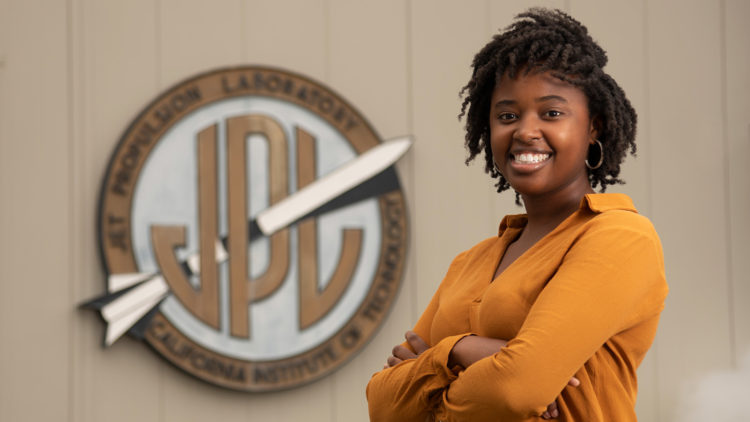Black Rocket Scientist: Puff Piece or Reality?
After all the phony Black geniuses in Jewish films and television, and the reality of African IQ, we are entitled to be skeptical. Also note that the “news media contact” for the promotional piece is one Matthew Segal.
by David Sims
IS Black NASA employee Janelle Wellons really as competent as the press is trying to make her seem?
I need someone with background checking skills greater than my own to investigate someone named Janelle Wellons. She works as an engineer for JPL (the Jet Propulsion Laboratory), operating the Lunar Reconnaissance Orbiter’s temperature sensing instrument. She’s a young Black female who attended MIT.
The Jet Propulsion Laboratory is puffing her mightily. See the Appendix below or follow this link to the original piece: https://www.jpl.nasa.gov/news/news.php?feature=7531
Now, there is a chance that Wellons deserves the praise she’s getting. But the weight of experience suggests that that isn’t the way to bet. We all remember the inflated promotions of allegedly brainy Blacks in the past, who sometimes turned out to be reasonably smart and/or accomplished, especially for a Black person, but nowhere near as much so as he/she would have to be to get similar praise if he/she were White. [Like most American Blacks, her ancestry is likely far from 100 per cent. African.]
JPL is, of course, the foremost space science organization in the world, bar none. I wanted to work for JPL myself, but either I wasn’t good enough, or there was some other reason they wouldn’t hire me, back in the 1980s. Is this Black woman really better than I was, or did she get hired because she’s Black?
Consider the article’s title: “A Young Engineer Steps Into the Light.” And, behold, it’s a Black female. How many young White male engineers do good work each year? Lots, I bet. How many of them get puff pieces published by their employers? None of them. Obviously, then, Janelle Wellons is being puffed because she is Black. The next question is whether she was hired, in part, because she is Black.
Read the article, and be sure to take notice of how tediously its text dwells on “racism,” specifically on the subject of allegedly discouraging comments made by Wellons’ allegedly “White racist” school peers. I say “allegedly” because we have no way by which to verify the truth of those statements.
Can we find out what Wellons’ mental potential really is? Does she really have the sort of mind you often find at places such as JPL? Does she actually do any engineering? Could she, say, produce from scratch the math needed for calculating the departure and arrival delta-vees for a hyperbolic heliocentric intercept orbit? Or is she merely smart enough to read instrumentation, obeying the instructions thereunto appertaining, and not goof it up too badly or too often?
Personally, I think that the Janelle Wellons “story” is a reprise of the “NASA’s Black Women Computers” story. Yeah, those women existed. Mostly as a Politically Correct PR stunt. They never were mission critical, contrary to how the mainstream media continually try to make them seem.
* * *
Appendix
A Young Engineer Steps Into the Light

In high school, Janelle Wellons excelled in her classes, especially math, and quickly climbed to the top of her class. By the spring of her senior year, she had an acceptance letter in hand from her dream school, the Massachusetts Institute of Technology. But while that should have been a joyous time, an incident with a high school classmate cast a long shadow.
“One of my classmates approached me in front of a group of friends and said, ‘We all know the reason you got accepted into MIT is because you’re black,'” Wellons recalled. “No one standing there said anything, and the fact that no one stood up for me spoke volumes.”
Today, Wellons shows no hint of how close she came to giving up — not because of the sting of one comment that broke the surface, but because of the doubts and questions that worked invisibly during her formative years.
Bright-eyed with an ebullient personality and hearty laugh, she works as an engineer at NASA’s Jet Propulsion Laboratory in Pasadena, California, where she operates the Lunar Reconnaissance Orbiter’s Diviner instrument — a radiometer that measures the surface temperature of the Moon. Wellons is also developing the system that will command the Multi-Angle Imager for Aerosols instrument, which will launch around 2022 to study how Earth’s pollutants affect people’s health on a global scale.
Just three years out of college, she is one of the youngest staffers on a Moon mission and an Earth mission. But while her progress has been quick, it was not easy.
A Gray Summit
Wellons grew up in South Jersey, the eldest of two siblings. Her mother was a secretary at an oil and gas corporation, and her father worked in warehouses. When she was about 6 years old, she went with her mother on a bring-your-child-to-work day and spent the morning surrounded by engineers doing demonstrations for the kids.
“It opened my eyes to realize: an engineer makes things!” she said. “I got that into my mind.”
But as she grew older, Wellons realized that reaching her goals would sometimes come alongside prejudice. The acceptance-letter incident wasn’t her only brush with racism. Wellons felt racial tension throughout her high school years, especially since she was often one of the few black students in her advanced placement classes.
“It kind of defined me. It was like they couldn’t see anything else,” she says. “In high school, people joke about bad things all the time and they always say they were kidding to make it OK, but after a time, it gets to you,” she says.
By her senior year, she recalled, “Something was just not right.”
It wasn’t feeling hurt that alarmed her. It was feeling nothing at all.
The spring of her senior year, Wellons received a call from the MIT Office of Engineering Outreach Programs with the news that she’d been awarded a scholarship.
“It should’ve been a very happy moment, but I didn’t feel anything and just hung up the phone and sat outside by the lockers,” she recalled. “When I realized I couldn’t feel happy about that, I realized there was something really wrong with me.
“That’s when the suicidal thoughts started to creep in, like, ‘Why can’t I have authentic reactions anymore?’ I knew it was a serious problem.”
Shedding the Label
Wellons’ parents sought out a therapist to help her, and as she entered MIT, things dramatically improved. She joined a Black student union, pledged a sorority and interacted with a multicultural community on campus.
“I definitely had a huge transformation in college,” she says. “When you take away the ‘smart black girl’ label, you become your own person and people can have a conversation beyond that.”
Still, her course load was demanding, and Wellons quickly realized she was, as she says, “in another realm of smart,” finding herself sitting next to a gold medal winner of the International Math Olympiad and doubting why she was admitted to MIT. “But that was a good thing.”
Although she thought she might major in mathematics, an aerospace engineering class changed her mind. The professor showed a photo of an astronaut fixing NASA’s Hubble Space Telescope and revealed that he was the person in the photo. Wellons was in awe.
“The opportunity to be taught by an astronaut was something I could not pass up,” she said. “I realized that’s what I wanted to do – I’m going to learn about space from experts! I was blown away by that.”
Another professor introduced her to the value of critical self-assessment during a capstone project involving an Antarctic penetrator probe. “He was a really tough professor who would angrily say, ‘This would never pass a review in the industry,’ and would heavily criticize our presentations,” she recalled. “But my standards are much higher now because of him, and I’m just as nitpicky.”
Real-time Engineer
Wellons applies that work ethic around the clock at JPL. She’s on call 24/7 for the Diviner instrument Reconnaissance Orbiter, sometimes getting calls at 2 a.m. and, on one rare occasion, had to rush to her laptop in the middle of a night out with friends.
“The one scary thing is, you are the engineer responsible for the instrument’s success,” she said. “You are the operator, and you can’t afford to be sloppy in this job. Instruments don’t sleep.”
Wellons’ typical day starts with checking on the health and safety of her instrument or, as she puts it, “making sure it’s alive and well.” Then she’ll work with the science team and, depending on what they would like to look at, help figure out if their requests can be met without putting the instrument’s well-being at risk.
“You’re in charge of making sure the scientists don’t push the limit,” she explained. “If you get too greedy, you might break the instrument.”
Then she creates the commands that will be sent to the instrument.
Community Builder
At JPL, Wellons balances gratitude for her career and awareness that being a Black female engineer comes with challenges.
“I am so thankful to be here, because growing up, I rarely if ever saw someone who looks like me working at a company so incredibly amazing, making history every day,” she said. “At the same time, that doesn’t mean [there aren’t] comments toward me. JPL is made up of individuals with their own thoughts and experiences and perspectives on life, so of course you’re going to have instances. It’s definitely not going to slow me down, though.”
To help spread the message of inclusion, Wellons is on the board of JPL’s African American Resource Team, which she’s helping revitalize.
“It’s about building a cultural community and encouraging other young people to come work here,” she says.
While Wellons often has work on the brain, she also carves out time to give back.
Last summer, she spent two weeks in South Korea, helping third- through sixth-graders at space camp learn about extraterrestrial volcanic bodies, launch bottle rockets and simulate rover driving.
Looking back on what she’s been through, Wellons remains focused on positivity and making the most of her time at JPL – seeking out mentors, gaining a wide variety of experiences and setting her sights on making her voice and her vision heard.
“Being here a short time doesn’t mean that you can’t accomplish great things quickly,” she said. But not easily, in her experience, and not without the right people on your side along the way.
“I am immensely thankful for the opportunities and support that have brought me to JPL, because it was never a straight shot,” Wellons said. “Don’t forget those who have supported you, believed in you, prayed for you, taught you and lifted you up when you felt especially down.”
* * *
Source: Author and Jet Propulsion Laboratory







Here’s a video of her encouraging women to consider STEM fields. https://www.youtube.com/watch?v=2Boh8bGkhCQ For a young engineer, she speaks reasonably well. She admits her grades weren’t that great and she got turned down for JPL internships several times. I’m wondering if her depression upon learning she was admitted to MIT was from realizing she wasn’t deserving of admission. There is a web site – CollegeConfidential.com – that has a forum where students who apply for early admission to various colleges. They self-report info about themselves such as test scores, GPA, extracurricular activities, race, ethnicity, gender, income etc. From a casual examination of the past several years, it does appear that white (and Asian) males require superior records to gain admission to MIT. I note more than a few black and hispanics… Read more »
I have some prime oceanfront real estate property in Mojave that you can have real cheap if you believe that this groid is a rocket scientist. Real cheap.
Maybe she is a scientist at Rocket Car Wash, making sure the soap is the right concentration and the wax is applied correctly.
I’m sure she is a very nice girl and very smart… at least compared to the average negroid. But she says she didn’t just want to be known as the “smart black girl,” yet it appears her blackness is pretty important to her. Note how she has hair in cornrows. Note how she is on the board of the African-American Resource Team at JPL (whatever the hell that is). She speaks of building a “cultural community” at JPL, and “encouraging other young people (i.e. negroes) to work at JPL.
How did we ever put a man on the moon, develop the space shuttle, etc., without these negroid geniuses, and having “cultural communities” at JPL and NASA?
She is an indirect recipient of the German technology and culture America inherited in 1945-unfortunately, America also inherited as a courtesy, Communism, from its ignoble ally, which, ironically is why such creatures are superpromoted by quota…Juden have everything to do with it since minority integrations disintegrate the Aryan goyim nations.
At least she didn’t go into medicine. Scary.
After reading the articles and doing a little research and comparing to my own experience in the technology field I would say she is fairly smart. According to her LinkedIn profile below she did graduate from MIT and that is quite an accomplishment even if she did get special help from tutors and other anti-white programs-which I’m sure she did. I would be very interested to see her grade point average and her rank in her class. She also received a lot of help financially: first from the MIT Outreach Program shown below and then, with the Outreach Program’s assistance no doubt, she received a scholarship from MIT. The Outreach Progran is free of charge and the tuition and other expensess at MIT is about $68,000 per year. Now her… Read more »
Will this smart white girl receive a scholarship to MIT?
“At 14, Rachel Bergey doesn’t know exactly where her future career path will lead, but having a patent for designing a Spotted Lanternfly trap and having just won a $10,000 prize at a national science fair competition gives an indication of what could be.”
http://www.montgomerynews.com/soudertonindependent/news/harleysville-teen-wins-national-science-fair-award-for-spotted-lanternfly/article_67da1050-fcfc-11e9-8e17-fbc40641b914.html
The Soviets put monkeys in space, not in their space studies programs.
Indeed, but sadly the American elector puts monkeys into the White house, possibly due to the number of monkeys allowed to vote.
“Weez beez rocket-doctas ‘N’ sheeit!”
Why don’t we take care of our people only
Blacks are a dead end and are not our people
Blacks are not like us they aren’t, they don’t have any of our qualities or tendencies. She is not a genius.
We just got to separate ourselves and deal with the problems our forefathers so regrettably left us
By the no Jews would do this in Israel
They wouldn’t even let an Arab or Palestinian
This is just more race suicidal creation and it’s cruel and unjust for our children
Excellent thought, one that guides the National Alliance in addition to other concepts we are working towards for the past 50 years. If we’re going to take care of our own kind, we must act like it. Here is more about the program of the National Alliance, Marina. If you’re truly sincere and serious about this, then join us and leave behind those who mouth the words and put some constructive action in their lives.
Your article is excellent, Mr. Sims, as are the comments under it. I couldn’t help but think of Dr. Pierce when reading that Ms.Wellons works as an engineer at NASA’s Jet Propulsion Laboratory in Pasadena, California. Pierce worked at that same facility as a young rocket scientist prior to dedicating his life to the preservation and welfare of his people, Aryan people. He earned his position at JPL on his merit, having already been a tenured professor of Physics at the age of 30, not because of his <ahem!> skin color. Wellons works for her people also. Good for her. But unlike Pierce did, she does so with much help from what has become an increasingly PC, anti-White Establishment. I featured the description of Dr. Pierce’s doctoral thesis in an… Read more »
I featured the description of Dr. Pierce’s doctoral thesis in an issue of our National Alliance BULLETIN last year. If I can find that in digital form, I’ll share that here for NV readers. — Found it. My memory of the chronology of Dr. Pierce’s career path back in the late 1950s and early ’60s was a off, above, but it is accurate here from the September 2022 issue of our BULLETIN. William Pierce, prior to devoting his life full time to working for his race, was an academic and literally a rocket scientist. While in his 20s, after receiving his bachelor of science degree in physics, he worked for a while at the Los Alamos Scientific Laboratory, in New Mexico, where the team on which he worked was attempting to control… Read more »
Lots of energy expended on a black woman who doesn’t appear to be a drug abuser on public assistance, plopping babies from unknown fathers – the usual White nationalist stereotype. Yes, the system centralized in Washington has programmed her advancement over smarter Whites – to disprove White superiority in hard sciences, by imposing diversity on institutions receiving federal grants, to benefit the self-esteem of Youth of Color who’d rather beat up their White classmates, unless diverted toward more intellectual pursuits. Our current paradigm relies on multiculturalism to do this in two structual examples: Our topical, verbose black woman gains because she questions that she possesses the innate skills that Whites who have been excluded from her landings at MIT or JPL possess, rather than flunk out of HS, work at… Read more »